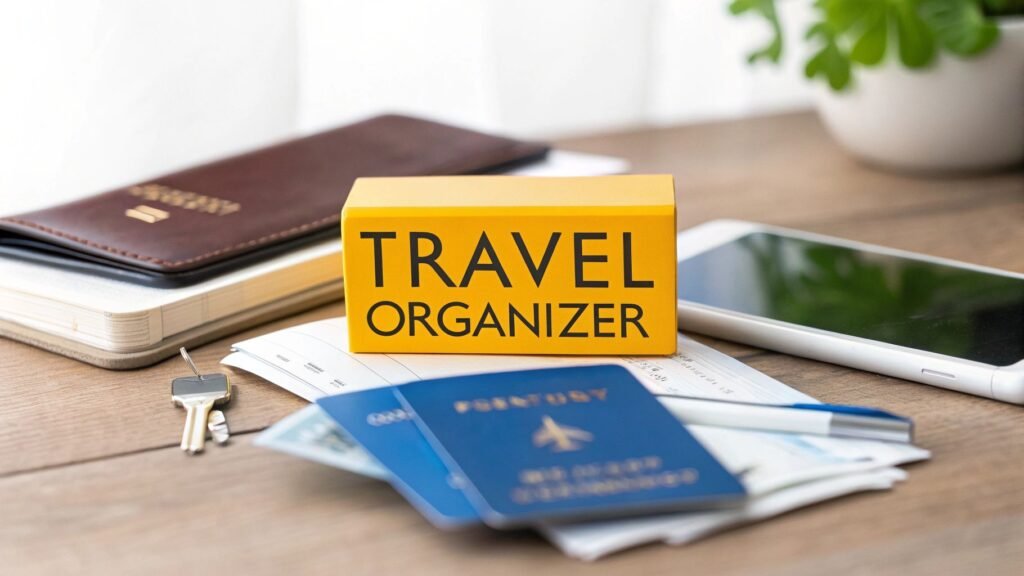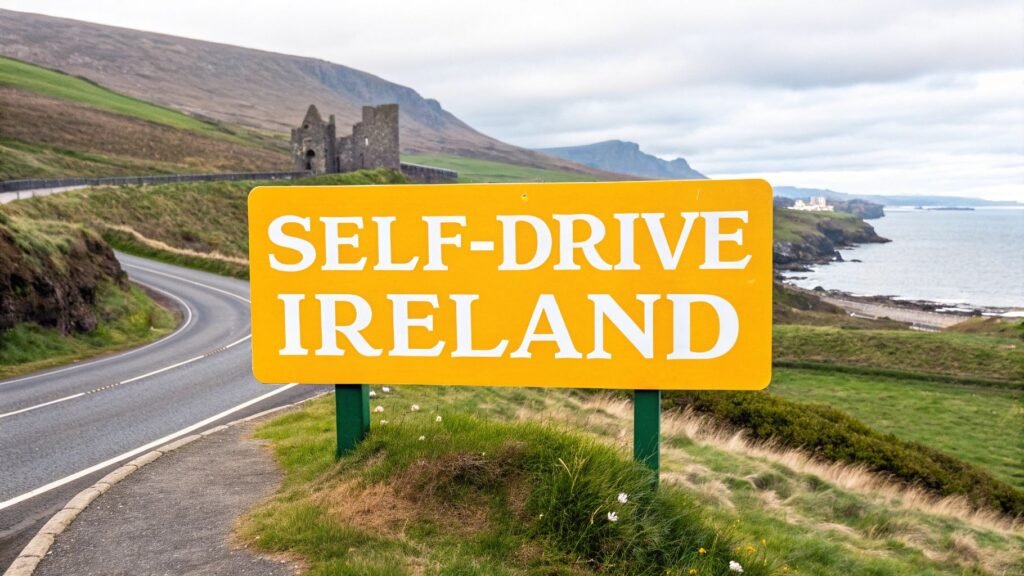The real secret to a brilliant self-drive adventure isn’t just the car you choose or the route you map out. It’s having all your critical paperwork sorted, safe, and instantly accessible. The best way I’ve found to do this, trip after trip, is with a dedicated travel documents organizer. Think of it as your mission control for everything from your passport to your car hire agreement. Honestly, it’s the single most important purchase you can make to turn pre-trip jitters into calm confidence.
The Secret to a Stress-Free Self-Drive Tour
Hitting the open road on a self-drive holiday is one of the most liberating ways to travel, but that freedom is built on good preparation. The biggest source of stress for most people isn’t picking the destinations; it’s that nagging worry you’ve forgotten a vital bit of paper. A purpose-built travel document organiser completely eliminates that fear by giving every essential item a single, reliable home.
Picture this: you pull up to a border crossing or the car hire desk, and you’re frantically digging through a backpack, papers flying everywhere. It’s a nightmare. Now, imagine smoothly pulling out a neat folder, flipping to the exact page, and handing over the right document in seconds. That’s the difference an organiser makes. It’s not just an accessory; it’s your system for staying efficient and sane.
This approach is smart for any traveller, but it’s crucial when you’re constantly on the move. Just look at the UK business travel market, which pulls in around £51 billion in revenue. Those professionals live and die by efficient document management to handle their packed schedules. It’s a lesson we can all borrow for a much smoother holiday.
Building Your Document Hub
Creating this central command centre is about gathering your physical papers and, just as importantly, their digital backups. Your organiser becomes the go-to place for all the non-negotiables that form the backbone of any road trip.
Before you go any further, take a moment to pull together everything on this list. It’s the absolute bare minimum you’ll need.
Here is a quick-reference checklist of the non-negotiable documents to gather for any international self-drive holiday.
| Document Type | Why It’s Essential | Where to Keep It |
|---|---|---|
| Passports & Visas | Your core identity and legal entry documents. No passport, no trip. | In the most secure, zipped pocket of your organiser. |
| Driving Licence & IDP | You’ll often need both to legally hire and drive a car abroad. | Together in an easy-access sleeve or pocket. |
| Car Hire Agreement & Insurance | Your proof of rental and what you’re covered for. Absolutely vital. | Keep the printed agreement and insurance certificate together. |
| Flight/Ferry Tickets | Your main transport documents to get you to your starting point. | Have them printed and easily reachable for check-in. |
| Accommodation Bookings | Printed confirmations can save the day if your phone dies or there’s no Wi-Fi. | Organise them chronologically by check-in date. |
Getting these essentials into one place means you’re not just ready for what you’ve planned, but you’re also equipped to handle any unexpected bumps in the road with total confidence.
A well-organised system ensures you are not just prepared for the planned parts of your journey, but also resilient enough to handle unexpected detours and requests with confidence and calm.
By gathering these items together, you create a simple, repeatable routine. This small habit transforms that dreaded pre-trip checklist from a source of anxiety into a straightforward, satisfying task. Our guides for planning unforgettable self-drive tours always stress this as step one. And for even more tips to simplify your planning, check out these essential travel resources.
How to Choose the Right Physical Organiser
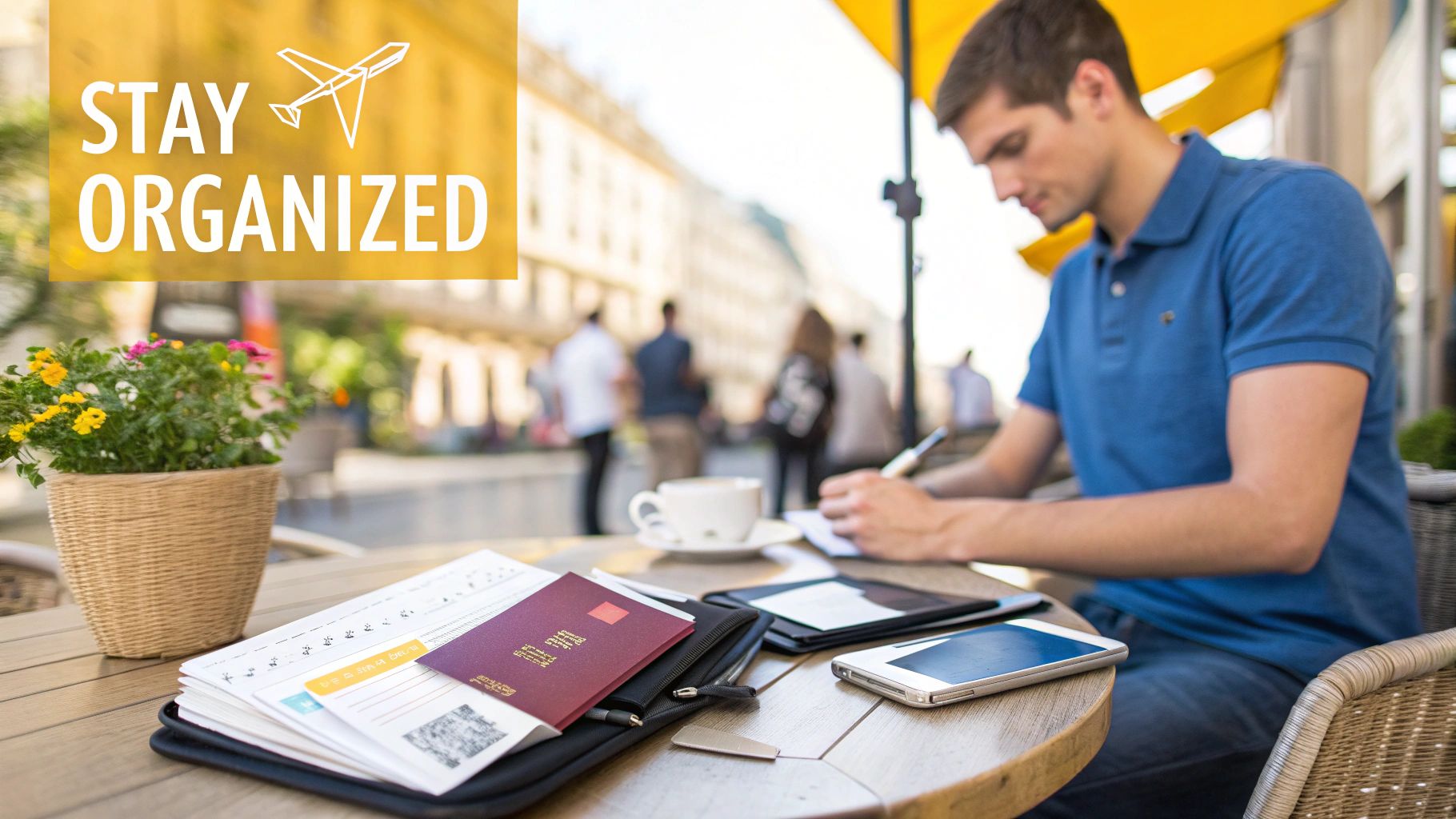
Choosing the right physical travel documents organiser is more personal than you might think. It’s not just about grabbing the first one you see. You’re really looking for a system that clicks with your travel plans, whether you’re a lone wolf on a quick city break or juggling paperwork for a family of four on a month-long road trip. The right choice gives you peace of mind; the wrong one just adds to the chaos.
Think of it as picking your trip’s co-pilot. Your specific needs should guide your choice. It’s a growing market out there—the passport holder segment alone was valued at roughly USD 1.78 billion in 2023 and is only expected to climb. If you’re curious about what’s driving this, you can dig into this detailed travel accessories market analysis.
All this growth means you have more options than ever. So, let’s break down what features genuinely matter for your kind of travel.
Consider Your Travel Style and Group Size
First things first, get real about who you’re travelling with and where you’re going. The perfect organiser for one person is completely different from what a family needs.
- The Solo Adventurer: If it’s just you, a sleek, minimalist passport wallet is usually all you need. Look for one that holds your passport, a few cards, your driving licence, and a bit of folded cash. Its main job is to be compact and easy to slip into a pocket or small bag.
- The Couple on Holiday: For two, you’ll want to size up slightly. An organiser with two passport slots and dedicated sections for both sets of documents is a game-changer. It keeps everything together and avoids the dreaded, “have you got my passport?” dance at every check-in desk.
- The Family on a Road Trip: Now we’re talking. A large, folio-style organiser is pretty much essential. You’ll need slots for multiple passports, a zipped section for different currencies, and clear pockets for things like tickets and car hire agreements. A model with a wristlet or crossbody strap is a massive plus, as it keeps your hands free for everything else.
Material and Durability
The material of your organiser says a lot about its lifespan and style. You’re essentially balancing toughness, looks, and how it’ll handle the places you’re taking it.
- Leather: You can’t beat leather for a classic, professional look that lasts. It’s incredibly durable and develops a nice, unique character over time. The downside? It can be a bit heavy and needs some care if it gets soaked.
- Nylon or Polyester: These synthetic fabrics are brilliant for rugged adventures. They’re lightweight, water-resistant, and tough as nails. They might not have the same stylish flair as leather, but their practicality is second to none.
Pro Tip: When picking a material, think about the setting of your self-drive tour. A trip through the often-rainy Scottish Highlands probably calls for a water-resistant nylon folio. For a city-hopping tour of England, a classic leather wallet would be perfectly at home.
Security Features and Compartment Layout
Finally, take a close look at the inside. A well-designed travel documents organiser should be all about efficiency and security. For me, RFID-blocking technology is non-negotiable these days. It acts as a shield around your credit cards and passport, stopping digital thieves from scanning your personal data.
Check the layout of the compartments. Are there enough slots for your cards? Is there a secure, zipped pocket for coins or a spare key? I find that a clear slot for a driving licence or ID is incredibly handy. The best organisers just make sense—they have a logical flow that lets you grab what you need without having to empty the entire thing out.
Creating Your Digital Document Safety Net
While having your physical documents in a tidy organiser is smart, a digital backup is your real trump card. I’ve seen it happen: a misplaced passport or lost car hire agreement on a self-drive tour can quickly derail a trip. But if you have a secure digital copy, a potential holiday-ruining disaster becomes a manageable hiccup. Getting this set up is straightforward, it just takes a little focused effort before you lock your front door.
First things first, you need to digitise everything. Take high-quality scans or really clear photos of every critical document. We’re talking about your passport’s photo page, both sides of your driver’s licence, your International Driving Permit (if you need one), any visas, your travel insurance policy, and all those booking confirmations—flights, hotels, and especially the car rental. You need to be able to read every single word and number, so check for sharpness and legibility.
Choosing Your Digital Storage
With your digital files ready, you need a safe place to stash them. There are a few reliable methods, and frankly, I often use a combination.
- Cloud Storage: This is my go-to. Services like Google Drive, Dropbox, or iCloud are brilliant because you can pull up your files on any device with an internet connection. The crucial feature here is offline access, which lets you save a folder directly to your phone. This is a lifesaver when you’re in a remote area with no Wi-Fi.
- Encrypted USB Drive: Think of this as your plan B. A small, password-protected USB stick, kept somewhere completely separate from your main bag (maybe in a jacket pocket or with your travel partner), is an excellent internet-free backup. It’s a great fallback if your phone gets lost or broken.
- Emailing Yourself: In a pinch, this works. Sending the document files to your own email address creates a simple, searchable archive. It’s not as secure as proper cloud storage, but it’s better than nothing.
This image breaks down the simple workflow for getting your core documents digitised and organised.
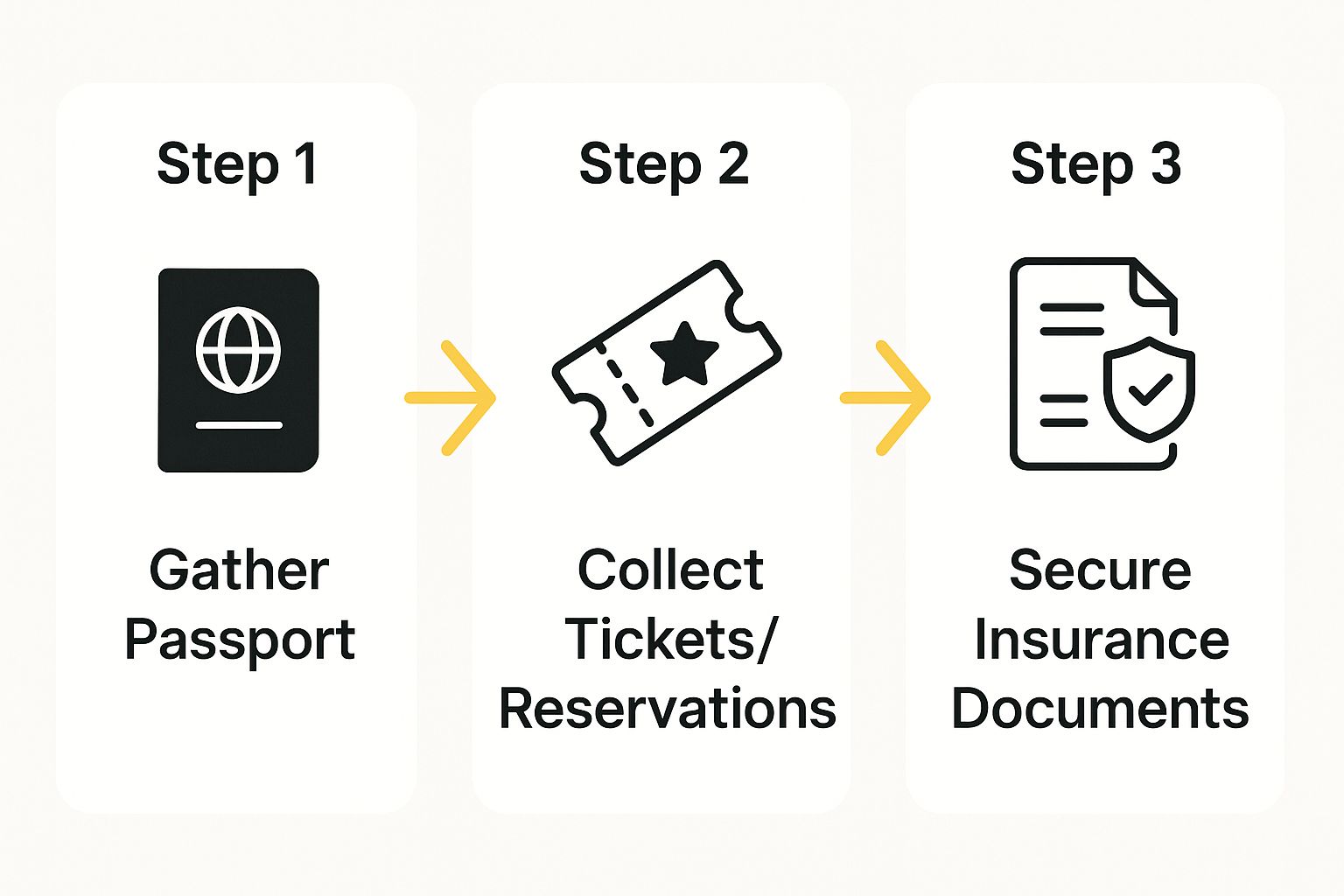
As you can see, the process starts with your most fundamental items: identification, transport paperwork, and safety documents. These are the absolute non-negotiables for your digital archive.
Activating Key Security Measures
Just uploading your files isn’t the final step. Protecting them is just as vital as keeping your physical passport safe. If you’re looking for more advanced ways to organise your files, learning about professional cloud document management solutions can offer some great insights.
Your digital copies are useless if they fall into the wrong hands or are inaccessible when you need them most. Always enable two-factor authentication (2FA) on your cloud account for an extra layer of security.
Here’s a final pre-trip check I never skip: make sure you’ve actually enabled offline access for your travel folder on your phone. Test it. Put your phone on airplane mode and try to open a few of the files. It’s a small check that confirms your backup system actually works when you’re off-grid. This kind of thorough prep is a cornerstone of smart travel, no matter what kind of travel styles you prefer.
Making Your Travel Organiser Work For You
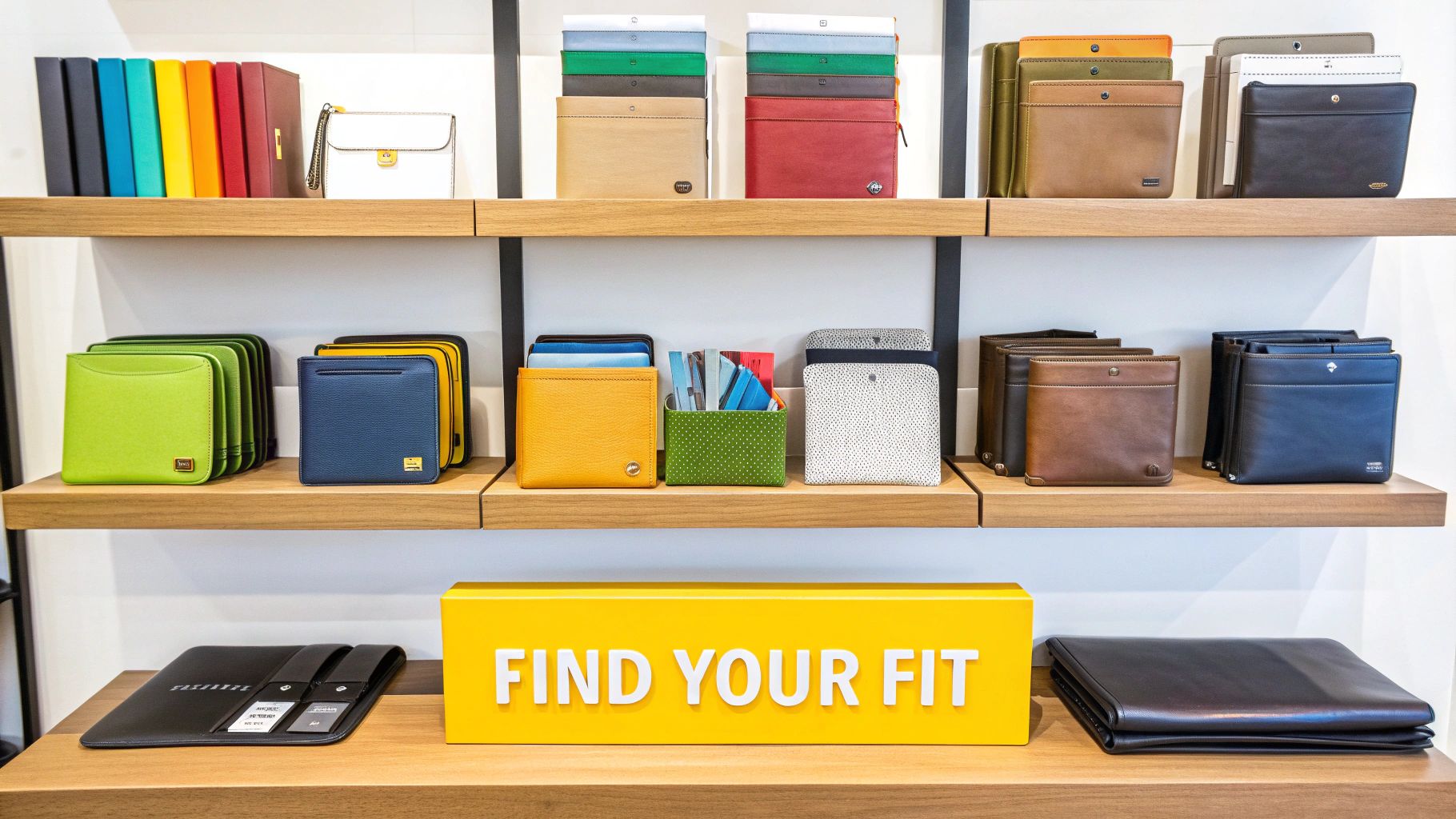
Having the right gear is one thing, but knowing how to use it like a seasoned pro is something else entirely. This is where you can turn a simple travel documents organizer into a tool that genuinely reduces stress and saves time. The real secret isn’t just stuffing things in; it’s creating a logical system. I’ve learned to organise items not by what they are, but by how often I’ll need to grab them.
It’s a bit like setting up a professional kitchen before a busy service—everything has its place so you can find it without thinking when the pressure’s on.
Think about your journey from start to finish. What’s the very first thing you’ll need? Almost without fail, it’s your passport and your boarding pass or ferry ticket. These need to be in the most accessible spot, maybe an outer pocket or the first slot inside the main zip. The last thing you want is to be fumbling through three compartments and a pile of papers just to get past a check-in desk.
This simple principle of “what first, what next” applies to everything else. You’re essentially creating zones within your organiser, each with its own purpose. It’s a small change that saves precious seconds and keeps you feeling calm and in control.
The Art of Strategic Layering
Layering isn’t just for your travel wardrobe; it’s a brilliant strategy for packing your document wallet. You’re basically creating an intuitive map that your hand will learn to navigate by feel.
- The Top Layer (Immediate Access): This is for anything you need at a moment’s notice. Think passports, tickets, and your primary driving licence. If your organiser has an external pocket, that’s its perfect job.
- The Middle Layer (Frequent Access): Here’s where you keep things you’ll need often, but not with the same split-second urgency. This includes your main credit cards, a bit of local cash for tolls or a quick coffee, and maybe your International Driving Permit.
- The Bottom Layer (Just-in-Case Access): These are the important but less-used documents. This is the ideal spot for printed hotel confirmations, the full car hire agreement, and your travel insurance details. A great tip is to arrange these chronologically to make finding the right one completely effortless.
Mixing Money and Emergency Info
A cluttered wallet is a one-way ticket to stress. Merging your travel documents with your money and emergency contacts needs a bit of thought. Please, don’t just stuff loose receipts and foreign coins into the same slot as your passport.
I’ve seen it countless times – people treating their travel organiser like a junk drawer. Instead, think of it as a pilot’s cockpit. Every dial and switch is placed for a reason. Your organiser should function the same way, with a dedicated spot for each item.
A smart way to manage this is to dedicate one specific zipped pocket just for currency. If you’re crossing multiple borders, use small envelopes or even paper clips to keep different currencies separate within that one pocket. For your bank cards, be ruthless. Only carry the essential ones and leave the department store loyalty cards at home.
Finally, a trick I swear by is including a small, laminated card with emergency information.
What to put on your Emergency Card:
- Next of Kin: Name and international phone number.
- Local Embassy/Consulate: Address and phone number for the country you’re in.
- Bank’s Lost/Stolen Card Hotline: The international freephone number.
- A Note on Blood Type & Allergies: This could be absolutely critical information in a medical emergency.
When you set up your travel documents organizer this way, you’re not just storing paper; you’re building a system. It’s a system that lets you find anything in seconds, helping you project calm and confidence whether you’re at a frantic check-in counter or a quiet border post in the middle of nowhere.
Keeping Your Documents Safe on the Road
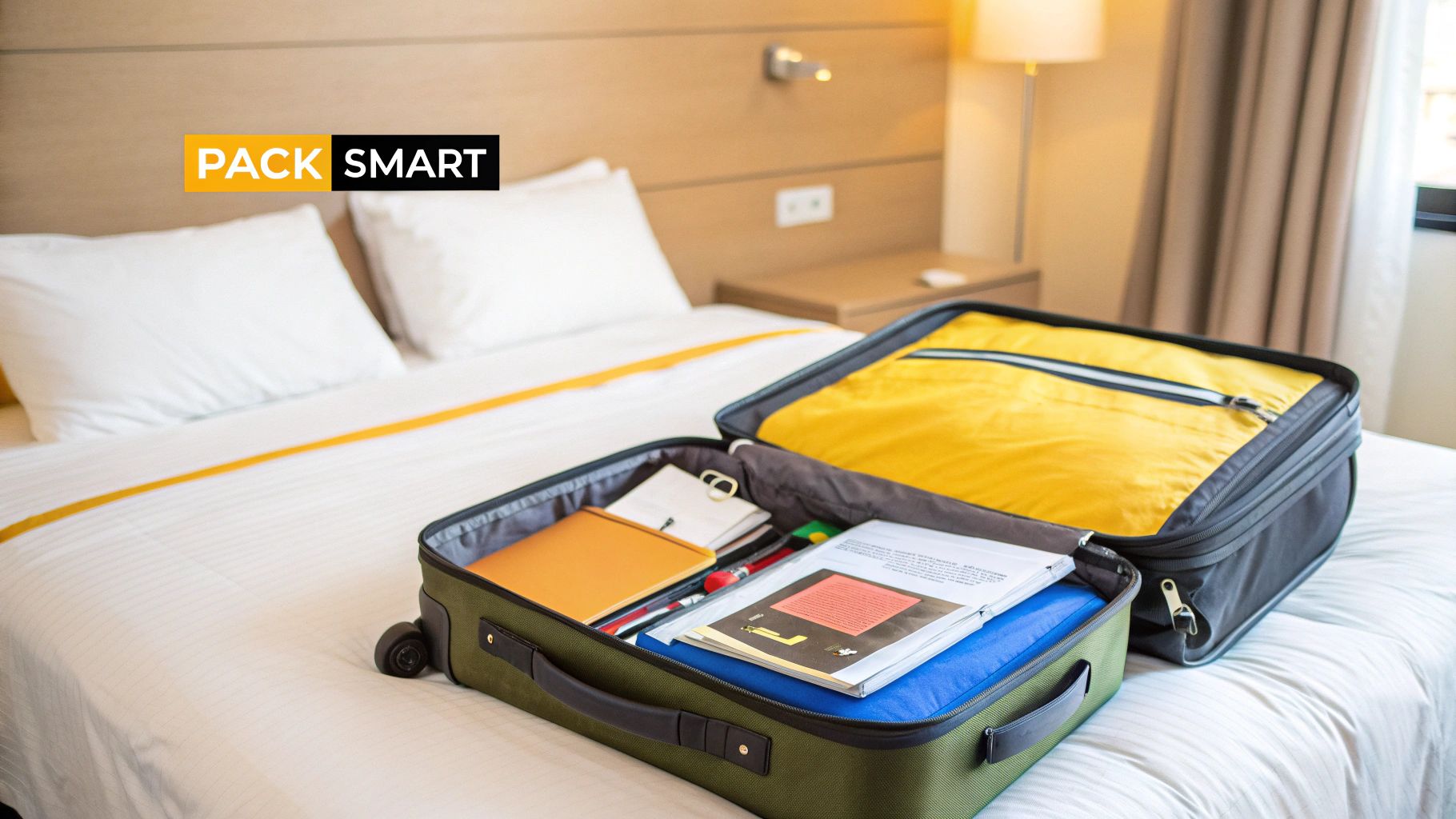
You’ve sorted, checked, and packed everything perfectly. Now that your self-drive tour is finally underway, the game changes from organising your documents to actively protecting them. Let’s be honest, a lost passport is the quickest way to bring a brilliant road trip to a grinding halt. Having a smart, real-world plan for safeguarding your travel documents organizer on the move is just as crucial as the prep work you did back home.
Where you are at any given moment really dictates your best move. If you’re heading out for a day of exploring, a discreet money belt or a cross-body bag worn at the front is your best bet. It keeps your must-haves physically on you and well away from opportunistic thieves. I’d strongly advise against leaving your main document stash in the car, particularly in busy tourist spots, unless it’s completely hidden in a locked glove box or the boot.
Finding the Right Safe Spot
Figuring out where to keep your organiser when it’s not on your person is always a trade-off between security and convenience. There’s no single perfect answer, so it’s all about making a sensible judgement call based on your immediate surroundings.
Here’s a breakdown of the usual options I’ve weighed up on my own trips:
| Storage Location | Pros | Cons |
|---|---|---|
| Hotel Safe | It’s generally the most secure option and protects against theft from your room. | You lose immediate access. It’s a pain if you suddenly need something you left behind. |
| Concealed Pouch | Your documents are always on you, giving you total control and peace of mind. | Can get uncomfortable in the heat. It might not be big enough for a family-sized organiser. |
| Vehicle | Super convenient on a road trip, especially when you need docs for police checks or border crossings. | Cars are a target for break-ins. Heat or damp can also damage your papers. |
A simple but effective tip I swear by: split up your critical documents. If you’re with a partner, have one person carry the passports while the other has the driving licences and car hire agreement. It’s a small thing, but it means a single theft won’t leave you completely high and dry.
Of course, document management becomes even more critical for bigger life changes. If you’re planning a more permanent relocation, reading up on preparing for a move abroad offers some fantastic insights into managing the mountain of paperwork involved.
When the Worst Happens
Even with the most careful planning, things can still go sideways. If your travel documents organizer gets lost or stolen, that digital backup you created becomes your absolute lifeline. The first thing to do is take a deep breath, stay as calm as you can, and get straight into your secure cloud storage or email.
With your digital copies, you can:
- Report the loss to the local police to get an official report or crime number.
- Use your passport copy to contact your nearest embassy or consulate for an emergency travel document.
- Get in touch with your bank to block any stolen debit or credit cards.
This kind of forward-thinking is essential. The document management services market in the UK, valued at around £1.2 billion in 2023, is built around this very blend of physical and digital security. It shows just how important it is to have both a physical system and a rock-solid digital backup.
Having a list of embassy contacts pre-saved and knowing the reporting procedures is a core part of the security plan for any trip, whether it’s a solo adventure or one of our guided group tours.
Common Questions About Travel Organisers
Even the most seasoned travellers have questions when getting ready for a big trip. Getting your travel documents organiser set up just right can feel a bit like solving a puzzle, but a few clear answers usually sort things out. I’ve pulled together some of the queries I hear most often to help you get organised with confidence.
What Is the Best Type of Organiser for a Family?
When you’re travelling with family, my top recommendation is always a larger, folio-style organiser. Trust me, you need a central hub to prevent that last-minute, panicked “Who has the passports?” scramble. Look for a model that has enough dedicated slots for every passport in your group.
A zippered section is also a godsend for keeping different currencies or important receipts separate. If you can find one with a wrist or crossbody strap, grab it—it’s a lifesaver when you’re trying to juggle kids and luggage through a busy airport or ferry terminal.
Should I Keep All My Documents Together?
It’s definitely tempting to pop everything into one convenient wallet, but from a security standpoint, a hybrid approach is much smarter. Your main travel documents organiser is for the things you’ll need to grab regularly: your passport, driving licence, and any current booking confirmations.
For everything else, it’s wise to keep backups in a totally separate and secure spot. This could be as simple as a photocopy of your passport’s photo page and a spare credit card tucked away in your locked suitcase. Your digital copies, safely stored in the cloud, are your ultimate fallback if the worst happens and you lose everything.
Is an RFID-Blocking Organiser Really Necessary?
While the real-world risk of someone digitally skimming your passport or card details is fairly low, an RFID-blocking organiser gives you an easy and inexpensive layer of security. These wallets are lined with a special material that stops the RFID chips in modern passports and credit cards from being read wirelessly.
For the small difference in price, the peace of mind you get from RFID protection is well worth it. Most experienced travellers I know consider it an essential feature. Think of it as cheap insurance for your identity and finances while you’re on the move.
How Can I Access Digital Copies Without Internet?
This is a very common and valid concern. The good news is that most cloud services have a simple solution: offline access. Before you even leave home, you can use apps like Google Drive or Dropbox to save a specific folder—say, your ‘Travel Documents’ archive—directly onto your phone’s memory.
All you have to do is find the folder within the app and select the option to “make available offline.” This means you can pull up any scanned document, regardless of whether you have Wi-Fi or mobile data. For a truly belt-and-braces approach, keeping a password-protected USB stick in your main luggage is also a brilliant idea.
Ready to start your next great adventure? Find your perfect self-drive tour with BTOURS and explore the UK, Ireland, and Greece with confidence. Plan your journey today!

